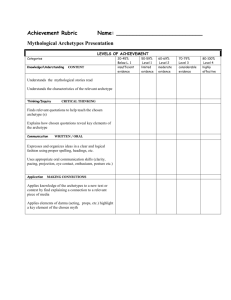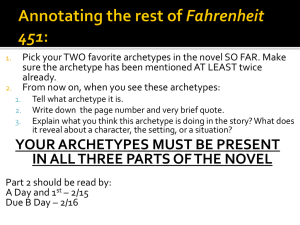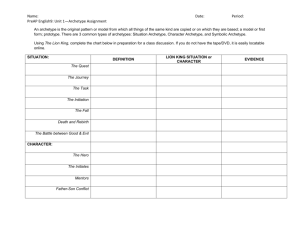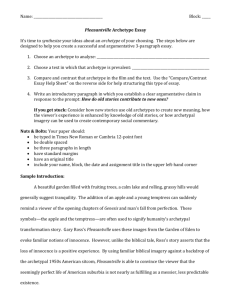As One A Manifesto for Individual Action and
advertisement
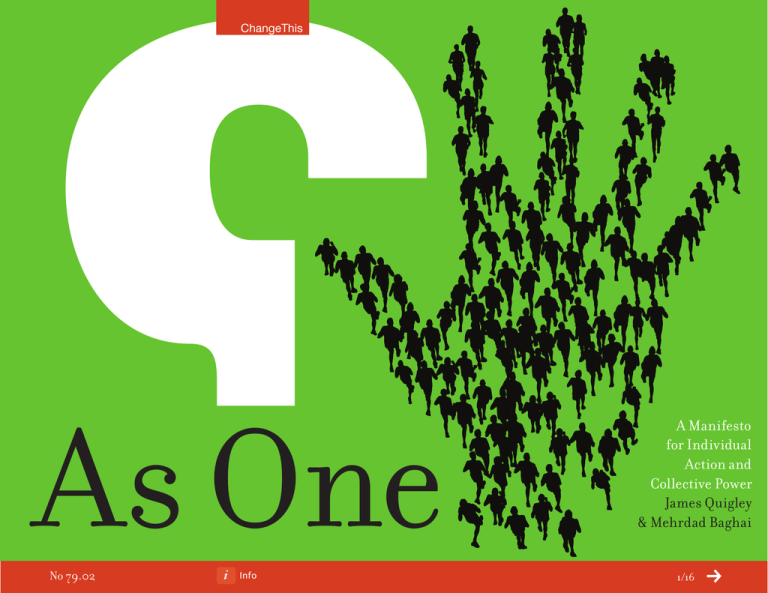
ChangeThis As One No 79.02 Info A Manifesto for Individual Action and Collective Power James Quigley & Mehrdad Baghai 1/16 ChangeThis As One. Five letters that make all the difference between a group of individuals and a unified team. Two words that transform individual action into collective power. One idea that can help you realize the full power of your people. A NE W IDE A Every day, millions of people around the world collaborate. We join, share, and cooperate with others from different countries and backgrounds, across organizations and industries. The world continues to advance because people are problem solving, innovating, and collaborating to make things happen. Some collaborations may be unintentional; others are quite deliberate. Some succeed; others fall short of their goals. The study of collaboration may be about working together, but it isn’t necessarily about working as one. Consider this scenario: the success of your new business growth strategy depends on the members of your organization seeing each other as a cohesive group and choosing to do what they must in order to achieve collective goals. Sound familiar? How confident are you that the members of your organization will perform the tasks required for your new strategy to succeed? Adding the phrase “as one” to another word changes its entire meaning. Imagine the possibilities: Working versus Working As One. Competing versus Competing As One. Winning versus Winning As One. The sources of inspiration are endless. Believing As One. Stronger As One. Succeeding As One. No 79.02 Info 2/16 ChangeThis As One behavior is a novel concept, an entirely different way of thinking about collaborative work. Leaders who want to engage their people in As One behavior need a new approach, distinct alternatives from the traditional command-and-control model of leadership. Think about your organization and ask yourself: Do my people think of themselves as one group? Are they truly committed to our organization’s goals and direction? Do they have the same ideas about how to work together? Do you measure how well your people work together? Did you even know that you could measure that? You can. Adding the phrase “as one” to another word changes its entire meaning. Imagine the possibilities … The sources of inspiration are endless. Believing As One. Stronger As One. Succeeding As One. If you are a leader—someone charged with executing a strategy, achieving a defined goal, or delivering results—you can use the information in this manifesto to understand how your people think about working together and to establish the conditions within your organization necessary for As One behavior to take root and succeed. No 79.02 Info 3/16 ChangeThis LE ADER SHIP VS. COLLEC TIVE LE ADER SHIP Leadership is an evolving discipline. Many say leadership is about people. They say a leader’s job is to develop people’s sense of belonging to their group. Others say leadership is about productivity. They think a leader’s job is to get people to work together. Some others say leadership is about purpose. They feel a leader’s job is to drive people’s commitment to the goals of the organization. We believe leaders need all three factors to be effective. As One collective leadership takes into consideration People + Purpose + Productivity. The term “collective leadership” describes the choices that individuals, leaders, and organizations make about how they interact to achieve common goals. Our research over the past two years has led to the identification of three key factors most commonly found in successful collective leadership: • First, people in effective organizations see themselves as part of the larger organization, not as members of a subgroup or as outsiders. This shared identity encourages people to act to achieve organizational goals. • Second, strategies succeed when large numbers of people commit to do the specific actions that the strategy demands. Directional intensity impels people to make the contributions sought by leaders. • Third, people who collaborate productively have common mental models of how work will get done. The presence of a common interpretation underlies the ability to cooperate. Most organizations do not track these factors or their compounded impact on the ability of leaders to lead effectively because, until now, there has not been a reliable way of measuring the factors or increasing their presence. No 79.02 Info 4/16 ChangeThis Leadership can be a lonely place. Leaders can go from being celebrated one day to being vilified the next. Despite the myriad proven and established processes for developing and implementing business strategies, regardless of how thorough and detailed your plans are, there is still an element of uncertainty, a dimension of risk that remains. What if you could eliminate the guesswork from leadership? Instead of crossing your fingers and hoping for the best, why not try something new? Start by getting leaders and their followers on the same page. A clear language that defines collective leadership and collaborative work will help you communicate to your followers the organization’s goals, the required tasks, and the critical role they play in achieving shared purpose. SHARED IDENTIT Y Shared identity measures the affinity people have for a group. In modern, matrixed organizations, replete with layers of hierarchy, it is critical for leaders to know to which parts of an organization their people feel they belong, because the success of those parts of the organization is what will matter to their people. If you chart parts of an organization, from those nearer at hand (e.g., “my work team”) to those farther away (e.g., the global parent company), it’s not surprising to find people’s affinities are strongest for their local teams. The slope of this curve tends to flatten for the more senior people within the organization, as they would have exposure and more frequent interactions with the farthest parts of the organization. No 79.02 Info 5/16 ChangeThis Understanding the importance of shared identity can inform engagement strategies and help you identify those in the organization most appropriate to deliver key messages. For example, when rolling out a new global strategy, you might consider enlisting the support of local leaders who are best equipped and positioned to translate global goals and objectives into messaging that will connect with the hearts and minds of their people at the local level (e.g., business unit, region, country, function, team). If an assessment of shared identity reveals affinities to be much higher for the organization as a whole than for any one division, you might choose to focus your communications efforts on promoting the enterprise strategy and allocate resources to work across boundaries. DIREC TIONAL INTENSIT Y Measuring directional intensity reveals the level of commitment members of an organization have to achieving the tasks required to achieve the organization’s strategy. Each member ranks his/her directional intensity for each of the organization’s goals in one of five categories: • Committed: ready to do what it takes to achieve the goal • Supportive: in favor of the goal, but doesn’t think achieving it is their responsibility • Undecided: waiting to see whether the organization needs their support or requires them to act • Unaware: unaware of the goal • Opposed: either actively taking steps to block or more passively speaking against the goal Directional intensity is different from attitude, which is often measured on a scale from “Strongly Agree” to “Strongly Disagree.” When attitudinal scores are predominantly positive, a leader may perceive the members of his/her organization to be “Supportive.” No 79.02 Info 6/16 ChangeThis However, when the lens of directional intensity is applied to the data, it’s not unusual to find the Supportive group is comprised of people who are “Committed,” “Undecided,” or “Unaware.” Ask any leader and she or he will tell you these classifications are forms of passive opposition, which can hinder the organization’s ability to accomplish its goals. COMMON INTERPRE TATION Using advanced analytical techniques, we developed 60 case studies and mapped a robust taxonomy to illustrate how leaders and followers interact in an organizational context. This work culminated in the discovery of eight different models of common interpretation, each of which can work effectively when applied in the right situations. 1 | Landlord & Tenants The Landlord & Tenants pairing is based on landlords’ top-down driven strategy and power—they control access to highly valuable or scarce resources. Landlords decide how to generate the most value for themselves and dictate the terms of participation for the tenants. Tenants voluntarily decide to join landlords, and it’s usually in their best interests to do so. However, once they do, landlords define the rules of participation. Landlords maintain their power by ensuring the best tenants are rewarded so that, over time, as the number of tenants grows, the landlords’ power increases. This archetype is great if leaders own or control assets that exhibit increasing returns to scale, but not so great if they have strong competition and you have not yet reached critical mass in scale or market share. Apple’s App Store’s popularity is an example of the Landlord & Tenants archetype. Apple convinced thousands of developers to create over 300,000 apps within two years for the iPhone and iPad in a way that no single company could have. No 79.02 Info 7/16 ChangeThis 2 | Community Organizer & Volunteers The Community Organizer & Volunteers pairing is based on volunteers’ bottom-up, direction-setting power. A community organizer is the glue that binds the activities of the volunteers together— his or her narrative attracts others to the cause. However, volunteers cannot be told what to do; rather, they must be given the choice to join on their own terms. The persuasive message of the community organizer motivates them to join in the cause, and it’s this common purpose that inspires volunteers to make a difference. Leaders should consider this archetype if they are seeking to realize economies of scale among a large group of similar people or entities that have traditionally not worked together, and if they have a noble purpose or cause that other people will embrace with some convincing. This is not the archetype to apply if one or a few of the volunteers are disproportionately influential and actively oppose your collective agenda, or if leaders cannot articulate a compelling logic around why cooperation is consistent with the enlightened self-interest of the volunteers or a noble purpose. The Linux operating system phenomenon is an example of the Community Organizer & Volunteers archetype. Linus Torvalds developed the Linux kernel and convinced enthusiasts from around the world to build something that has challenged the platforms of software giants. Instead of crossing your fingers and hoping for the best, why not try something new? No 79.02 Info 8/16 ChangeThis 3 | Conductor & Orchestra The Conductor & Orchestra pairing is based on highly scripted and clearly defined roles that focus on precision and efficiency in execution as defined by the conductor. The orchestra members, who have similar backgrounds, need to be fully trained to comply with the requirements of the job and, therefore, must be carefully selected to ensure they fit the strict culture and can perform the scripted tasks. Belonging to the orchestra provides members with the best way to make a living and the ability to focus on tasks at which they excel. This archetype is great if leaders require and value absolute precision and consistency in execution, or if they believe that the division of labor and standardization of processes will lead to lowest cost status. It’s not ideal if the leader’s operating model is being challenged by new disruptive models. Medco Health Solutions’ protocol-driven pharmacy is an example of the Conductor & Orchestra archetype. Medco developed a way for its 2,500 pharmacists to deliver more than 100 million prescriptions per year with Six Sigma accuracy. 4 | Producer & Creative Team The Producer & Creative Team pairing is typically about producers providing their creative team with the freedom to do their best work and reach their natural potential. This pairing is led by legendary, charismatic producers who bring together a team of highly inventive and skilled independent individuals to achieve the producers’ objective. Producers guide the vision and overall progress, while the creative team develops ideas through frequent meetings and interactions using an open culture of collaboration. Dissent is used to push creative boundaries. To maintain longevity in their industry, producers and creative teams need to continuously come up with new and innovative ideas. This archetype is great if leaders place value on creativity and substantial innovation above all else, but not ideal if the organizational culture is not truly supportive of open feedback, where dissent and sharing of ideas are not fully encouraged. No 79.02 Info 9/16 ChangeThis Cirque du Soleil’s show creation process is an example of the Producer & Creative Team archetype. Guy Laliberté and the thousands of Cirque du Soleil performers repeatedly create breathtaking shows that combine their extraordinary and diverse talents. 5 | General & Soldiers The General & Soldiers pairing has a command-and-control-type culture combined with a multilevel hierarchy organized around the general’s clear and compelling mission. Soldiers’ activities focus on clearly defined and scripted tasks. Soldiers are motivated by advancing up the hierarchy through well-defined roles at all levels. Soldiers undergo extensive training to understand the army and its culture and to learn specific skills. They are committed to the mission, the overall institution, and each other, while the general provides strong top-down authoritarian direction to motivate and direct them. Leaders should consider this archetype if they are looking to coordinate similar activities among large groups of people who cannot all directly communicate with each other, or if they have a high degree of confidence that they have a winning strategy. This archetype is not ideal if there is any conflict, confusion, or doubt over who is fully in command or if leaders cannot easily disaggregate their strategy into independent elements. The career advancement process at Marriott is an example of the General & Soldiers archetype. Marriott’s language programs create opportunities for foreign entry-level workers while enabling the hotel chain to maintain the industry’s lowest staff turnover rates. 6 | Architect & Builders The Architect & Builders pairing focuses on the creative collaboration between groups of diverse builders that have been recruited by visionary architects to bring a seemingly impossible dream to life. Their visions are so innovative and ambitious that they can’t be achieved simply by using conventional means, so builders often need to reinvent and rethink ways to achieve them. Builders strive to meet ambitious deadlines and milestones mapped to deliberate work cycles. No 79.02 Info 10/16 ChangeThis As each milestone is completed, the builders become one step closer to bringing the architect’s dream to reality. This is a great archetype if the leader has a continuous innovation goal that requires participants to push beyond the normal boundaries, but not so ideal if builders are primarily driven by short-term financial incentives. The development of the world’s cheapest car, the Tata Nano, is a great example of the Architect & Builder archetype. Ratan Tata, CEO of the Tata Group, convinced hundreds of automotive suppliers to re-invent their traditional car components to deliver a car for just US$2,500. 7 | Captain & Sports Team The Captain & Sports Team pairing operates with minimal hierarchy and acts like a single cohesive and dynamic organism, adapting to new strategies and challenges with great agility as they appear. Members of the sports team have a strong shared identity. They have extensive and networked communication channels and carry out the same highly scripted, repeatable tasks. There is strong camaraderie and trust among the sports team members—the collective good outweighs the needs of the individual—while captains are there, on the field as part of the team, to motivate and encourage. This archetype is best in situations where leaders have a very high degree of trust in the skills and judgment of those around them, but not so ideal if there are mavericks or rogue elements that will pursue their own agenda. The low-tech adaptability of the dabbawalas, the illiterate lunchbox delivery men of Mumbai, is an example of the Captain & Sports Team archetype. Dabbawalas deliver more than 200,000 hot meals each day with only one out of every six million failing to arrive on time. No 79.02 Info 11/16 ChangeThis 8 | Senator & Citizens The Senator & Citizens pairing is based on a strong sense of responsibility to abide by the values or constitution of the community, which have been outlined by the senators. Sovereignty is held by both senators and citizens, and the citizens thrive on the values of democracy, freedom of expression, and autonomy. Since citizens are autonomous, the community structure is flexible. There is no set framework or direction organizing the citizens. Instead, much of their direction is emergent as they gather ideas and collaborate with other citizens. Senators are the guiding intelligence for the citizens and oversee decision-making for the community. This archetype should be considered in situations where leaders place value on creativity and substantial innovation above all else. It is not ideal if people differ widely in terms of core values or are largely uninformed, inactive, or uncomfortable with ambiguity. The flexible structure and unique culture of W. L. Gore & Associates, inventors of GORE-TEX®, is an example of the Senator & Citizens archetype. Gore continues to be one of the world’s most innovative companies with few job titles, no job descriptions, and no defined organization charts. A clear language that defines collective leadership and collaborative work will help you communicate to your followers the organization’s goals, the required tasks, and the critical role they play in achieving shared purpose. No 79.02 Info 12/16 ChangeThis Why is it important to have alternative models of leadership? Strategies must be executed by people, after all, and not all people are the same. The timeless challenge of leadership is that you cannot get large groups of people to behave As One if they do not identify with each other as a unified group or team. Your people will not achieve their full potential if they have different interpretations about how they are supposed to work together. Your organization will not be as successful as it can be if your people are not committed to the organization’s goals and to achieving the specific required tasks for which they are responsible. The timeless challenge of leadership is that you cannot get large groups of people to behave As One if they do not identify with each other as a unified group or team. THE A S ONE APPROACH The As One model for collective leadership applies to a wide variety of leaders in many diverse situations. The As One concepts aren’t just relevant to employees or individuals within an organization. They are far-reaching, with the capability of affecting a variety of interesting contexts that extend beyond the normal boundaries of your organization. Try applying As One to generate collective behavior from partner organizations, within vendors in your supply chain, or among large groups of customers. No 79.02 Info 13/16 ChangeThis Although the contextual variables may be unique, the As One approach is fairly universal in its application. Step 1 | Diagnostic Assess the suitability of how your organization thinks about working together to achieve the highest priorities of your collective agenda. Identify your organization’s default archetype. Step 2 | Interventions Strengthen your whole organization’s ability to work As One in your default archetype when it is a good fit with the agenda. Overlay a secondary archetype for specific priorities that do not match your default mode and manage both archetypes in a complementary way. Narrow the field and choose a primary archetype to be developed over time when you do not have a clear default archetype. Step 3 | Adoption Embed the broader application of the As One approach inside and outside the organization. Assess, refine, and repeat as required; the search for alignment is a continuous one. No 79.02 Info 14/16 ChangeThis What’s next? The success of As One depends on whether you and other leaders all over the world will join us in this collaborative project. We’ve only just scratched the surface of the potential of As One. Collective leadership is very much a “next practice” domain. While much work has gone into creating a common language of leadership and developing a rigorous framework for leaders to understand what it means to work As One, there is still a great deal of knowledge to discover. So, please, take a moment to share your As One story. And join us on this collective leadership journey. Register online at www.AsOne.org and contribute to the growing As One knowledge base. You can download a free iPhone, or iPad, app to stay current on As One information or use our archetype classifier to identify your archetype. No 79.02 Info 15/16 ChangeThis info About the Authors James H. Quigley is CEO of Deloitte Touche Tohmatsu Limited, the world’s leading consulting and professional services organization. DTTL and its network of member firms comprise approximately 170,000 employees in more than 150 countries. He has been with the organization for over 30 years. Prior to his current role, Jim was CEO of Deloitte United States. Mehrdad Baghai is Managing Director of Alchemy Growth Partners, a boutique advisory and venture firm in Sydney, Australia. Mehrdad has been advising global companies on growth, organization design, and transformation for the last 20 years. He is currently co-leader of the As One flagship project, the Deloitte organization’s global initiative on collective leadership. send this Pass along a copy of this manifesto to others. buy the book Get more details or buy a copy of Quigley & Baghai’s As One. Subscribe Sign up for our free e-newsletter to learn about our latest manifestos as soon as they are available. Born on date This document was created on February 16, 2011 and is based on the best information available at that time. ABOUT CHANGETHIS Copyright info WHAT YOU CAN DO ChangeThis is a vehicle, not a publisher. We make it easy for big ideas to spread. While the authors we work with are responsible for their own work, they don’t necessarily agree with everything available in ChangeThis format. But you knew that already. The copyright of this work belongs to the author, who is solely responsible for the content. You are given the unlimited right to print this manifesto and to distribute it electronically (via email, your website, or any other means). You can print out pages and put them in your favorite coffee shop’s windows or your doctor’s waiting room. You can transcribe the author’s words onto the sidewalk, or you can hand out copies to everyone you meet. You may not alter this manifesto in any way, though, and you may not charge for it. ChangeThis is supported by the love and tender care of 800-CEO-READ. Visit us at 800-CEO-READ or at our daily blog. No 79.02 Info This work is licensed under the Creative Commons Attribution-NonCommercialNoDerivs License. To view a copy of this license, visit Creative Commons or send a letter to Creative Commons, 559 Nathan Abbott Way, Stanford, California 94305, USA. Cover image from iStockphoto® 16/16

